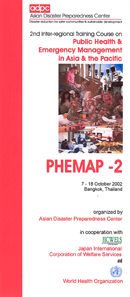|
 PHEMAP
- 2 Brochure
PHEMAP
- 2 Brochure |
|
|
A
programme of course in Public Health and
Emergency Management in Asia and the Pacific (PHEMAP)
Introduction
In 2001, the Asian Disaster Preparedness
Centre (ADPC)
in Thailand was approached by the Regional Offices of
WHO for South East Asia (SEARO)and
the Western Pacific (WPRO)
to organise and deliver a course on public health and
emergencies for member states of the two regions. Following
a series of meetings, a contract was signed with the donor,
Japan International Cooperation for Welfare Services (JICWELS)
and the first course was delivered in March 2002.
The title of the programme is Public
Health and Emergency Management in Asia and the Pacific
(PHEMAP). Within this framework, courses will be offered
at international level for senior MOH staff, supported
by JICWELS, and at national level for local MOH staff,
with funds from other sources.
Justification for the audience of the
training programme
There are many courses around the world
offering training in emergencies and public health. However,
they tend to be focussed on training people as individuals
and are most relevant to staff of UN agencies and international
NGO. The majority of courses deal only with issues related
to the care of refugees in complex emergency situations,
such as Bosnia and Rwanda. There is no international course
which deals with trauma management in the context of natural
disasters. There are no international courses designed
specifically for government policy makers; all currently
available courses focus on technical and practical skills.
Based on these observations, the organisers
of PHEMAP identified a need for a comprehensive training
programme for Ministries of Health as institutions responsible
for providing a comprehensive and coherent response to
an emergency. The PHEMAP courses are adapted to all levels
of a Ministry (from National Directors to District Medical
Officers) and will cover the problems that Ministries
actually face i.e. trauma and public health issues in
natural disasters and mass accidents. These issues are
covered from policy, management, organisational and technical
perspectives.
Justification for the content of programme
This training programme was designed by looking
at needs and designing courses using evidence-based criteria.
The workload from major emergencies and disasters facing
the region is: (base on data from CRED)
|
 82% of disaster events in Asia and Pacific are caused by
just 4 hazards: mass accidents (37%), floods (18%), storms
(19%) and earthquakes (8%);
82% of disaster events in Asia and Pacific are caused by
just 4 hazards: mass accidents (37%), floods (18%), storms
(19%) and earthquakes (8%); |
| |
•
PHEMAP response – focus on these hazards only, as other
courses are available covering complex emergencies, and
other hazards cause relatively few casualties in the region; |
 floods are significantly associated with extended periods
of excess morbidity from communicable diseases while storms
and earthquakes cause displacement of large populations
into temporary shelters for long periods, which causes significant
public health risks;
floods are significantly associated with extended periods
of excess morbidity from communicable diseases while storms
and earthquakes cause displacement of large populations
into temporary shelters for long periods, which causes significant
public health risks; |
| |
• PHEMAP
response – focus on meeting long-term post-disaster
public health needs and the public health needs of displaced
peoples; |
 95% of morbidity and mortality in the first week after a
disaster is due to trauma;
95% of morbidity and mortality in the first week after a
disaster is due to trauma; |
|
•
PHEMAP
response – policies and guidelines for mass casualty
management and hospital planning are needed at national
level; |
 72% of disasters in the Region involve less than 50 trauma
victims (deaths plus injuries);
72% of disasters in the Region involve less than 50 trauma
victims (deaths plus injuries); |
|
•
PHEMAP
response – mass casualty management organisational
capacity is needed at provincial level; |
 60% of these trauma victims need only simple first aid or
primary medical care, while 95% of disaster deaths occur
before the victim reaches a hospital;
60% of these trauma victims need only simple first aid or
primary medical care, while 95% of disaster deaths occur
before the victim reaches a hospital; |
|
•
PHEMAP response – pre-hospital knowledge and skills
and hospital planning are needed at the local level to save
lives; |
The
PHEMAP programme will offer customised courses targeted
to the needs of the different levels of health sector managers,
from national (policy and guidelines) to provincial (programme
man-agement) and local (implementation) levels, as well
as directors of relevant institutions such as major hospitals
and academic institutes (training and education).
Participants
The courses will be relevant to senior health professionals
such as national and provincial MOH officers, health sector
emergency managers, hospital directors, teaching staff from
academic institutions, designated WHO programme focal points
and other relevant health professionals. Ideally, participants
should be involved in formulating and/or updating national
policies and strategies for emergency health management,
or in national training and educational programmes, as part
of their normal duties.
Target Countries
The target countries are Vietnam, Lao PDR, Cambodia, Malaysia,
Philippines and Papua New Guinea (countries covered by WHO/WPRO)
and Indonesia, Thailand, Bangladesh, Nepal, India and Sri
Lanka (countries covered by WHO/SEARO. Japan will send six
participants to each course. It is expected that a country
will send two participants each. There will not more than
30 participants attending each course.
|
|
|
|

